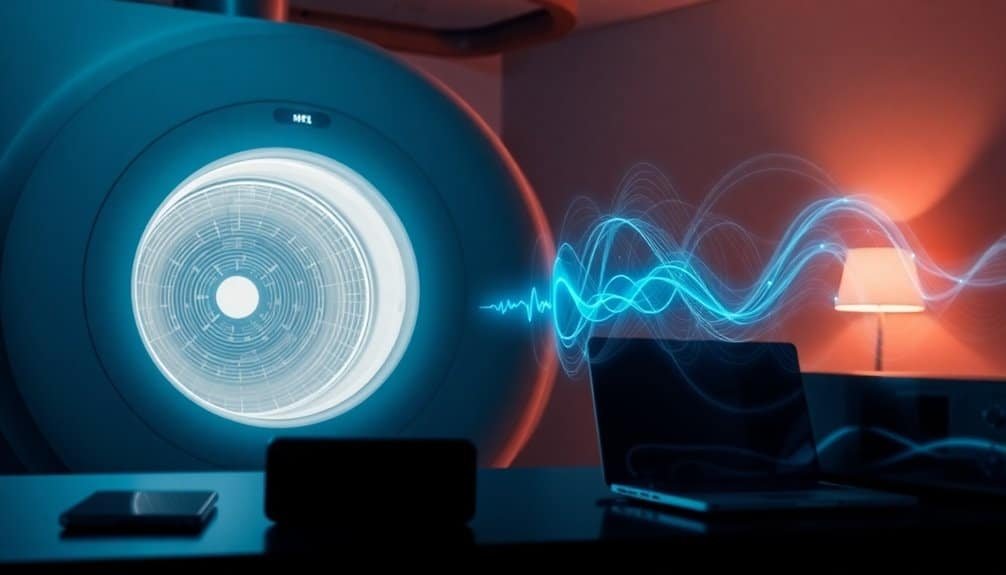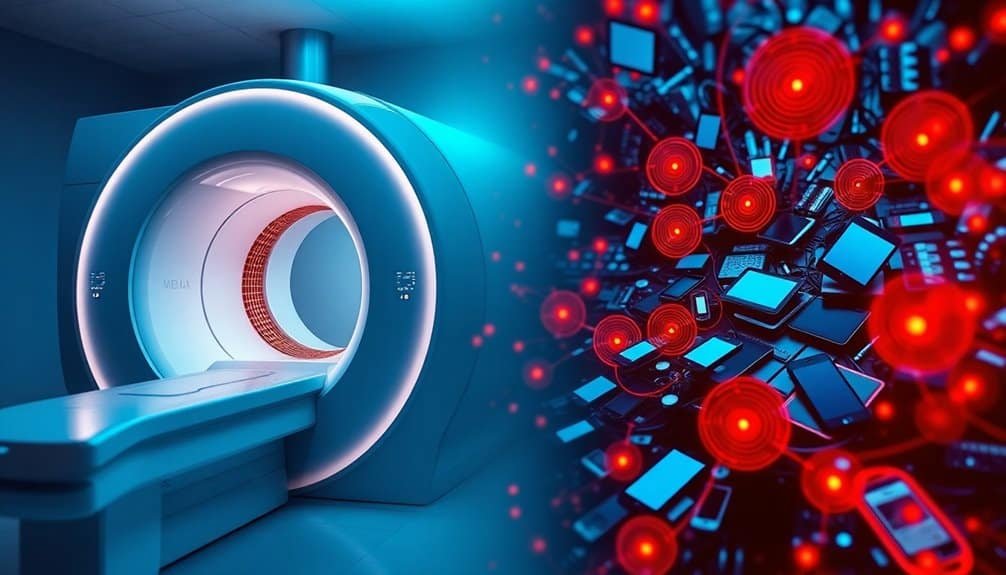Benefits of EMF: Medical Uses Vs Everyday Exposure
EMF is beneficial in medical applications like pain reduction and tissue regeneration through non-invasive therapies. While everyday exposure from devices such as microwaves and Wi-Fi routers is common, it is generally considered low risk, though further research is necessary.
Balancing EMF‘s medical advantages with potential everyday exposure risks is crucial. Continued exploration can offer clearer understanding of its impacts.
Disclaimer: As an affiliate, I may collect a share of sales from the links on this page.
Understanding EMF and Its Types

When you think about electromagnetic fields (EMF), it’s essential to grasp their fundamental characteristics and classifications. EMF consists of electric fields and magnetic fields, both integral to our understanding of electromagnetic energy. These fields can be classified by frequency into bands such as radio waves, microwaves, and more. Each band has distinct properties, affecting how they interact with matter. Higher frequencies correspond to higher energy levels, influencing applications and their potential effects on health. Electromagnetic induction is a crucial process that highlights the interrelationship between electric and magnetic fields. Sources of EMF include natural phenomena and electronic devices, shaping our daily exposure. Understanding these distinctions is vital for informed discussions on EMF’s benefits and risks. Additionally, the classification theorem reveals that electromagnetic fields can be represented by a real bivector in Lorentzian spacetime, providing insight into their mathematical structure.
Therapeutic Applications of EMF
Therapeutic applications of electromagnetic fields (EMF) offer innovative approaches to pain management and tissue regeneration. These methods provide effective, non-invasive treatment options, minimizing surgical risks. Here are some key benefits:
- Reduces pain and inflammation, particularly in musculoskeletal disorders.
- Promotes cell proliferation and tissue regeneration, aiding healing processes. Recent studies indicate that pulsed magnetic fields effectively alleviate musculoskeletal pain, enhancing overall treatment efficacy.
- Displays anti-inflammatory properties for chronic pain management.
- Enhances drug effectiveness and cellular signaling, improving treatment outcomes.
Everyday Exposure to EMF

Everyday exposure to electromagnetic fields (EMF) is an integral part of modern life, stemming from various sources that most people may not even consider. Common household appliances, such as blenders and electric irons, emit EMFs. Sleeping near electrical devices heightens exposure, especially when left on. Additionally, your laptop and Wi-Fi router contribute to radiofrequency radiation. Living close to power lines or using multiple electrical devices at work increases your exposure levels. Public exposure varies by location and activities, leading to higher levels near overhead power lines and motorized equipment. To minimize risks, consider placing devices away from sleeping areas, limiting usage time, or exploring non-electrical alternatives. Awareness of EMF sources is essential for maintaining a healthy lifestyle.
Common Sources of EMF in Daily Life
Common sources of electromagnetic fields (EMF) are pervasive in daily life, stemming from various electronics and devices households frequently use.
These include:
- Televisions and computers, which emit low-frequency EMFs during operation.
- Kitchen appliances like microwaves and blenders generating measurable magnetic fields.
- Cell phones, operating in the 1.8–2.2 GHz range, emitting both low-frequency and radiofrequency EMFs.
- Wi-Fi routers, constantly radiating radiofrequency fields for connectivity.
Awareness of these sources helps you understand your exposure to EMF, facilitating informed decisions about usage and placement in your home and workspace. Additionally, reducing WiFi exposure can lead to improvements in mental health and sleep patterns for those sensitive to EMF radiation.
Potential Health Risks Associated With EMF

Potential health risks associated with electromagnetic fields (EMF) warrant careful consideration as technology becomes increasingly integrated into daily life.
The International Agency for Research on Cancer (IARC) classifies extremely low-frequency EMFs as “possibly carcinogenic,” suggesting links to childhood leukemia. High radiofrequency levels can cause tissue heating, while low-frequency EMFs may increase oxidative stress and free radical production.
Reported neurological symptoms include headaches, fatigue, and anxiety, yet no definitive link between EMF exposure and brain tumors exists. Regulatory bodies like the WHO continue to study these risks, though a scientific consensus remains elusive, emphasizing the need for ongoing research and awareness.
The Balance Between Medical Uses and Risks
In balancing the medical uses and risks of electromagnetic fields (EMF), it’s essential to differentiate therapeutic applications from everyday exposure.
- Medical uses involve controlled dosages designed for specific treatments.
- Everyday exposure often lacks these targeted health benefits.
- Regulatory standards guarantee safe exposure levels in medical and non-medical settings.
- Public awareness is important in distinguishing between medical advantages and potential risks.
Understanding this balance is critical. While EMF therapies offer significant medical benefits, unmonitored exposure may pose risks.
Ongoing education guarantees informed decisions about both therapeutic and non-therapeutic electromagnetic field use.
Future Research Directions on EMF
As researchers explore the vast potentials of electromagnetic fields (EMF), multiple avenues emerge for future investigations. EM modulation holds promise in cancer therapy through precise control of cell cycle processes.
Personalized treatment strategies could enhance outcomes, addressing tumor heterogeneity effectively. Additionally, integrating EM modulation with AI and nanotechnology may improve targeting precision and therapeutic efficacy.
In cognitive enhancement, studies on EM fields suggest benefits for focus and learning, especially in neurodevelopmental disorders.
Optimizing EM parameters and conducting comparative studies with other methods will be essential. Advanced imaging technologies can deepen understanding and drive innovations in materials science and device development, revealing new applications.
Public Awareness and Safety Guidelines
Given the growing public interest in electromagnetic fields (EMF), it’s crucial to provide clear information regarding their potential health effects. Here’s what you need to know about public awareness and safety guidelines:
- Public Concerns: Many worry about EMF effects, especially from power lines and mobile devices.
- Informational Initiatives: Organizations like WHO educate on EMF exposure.
- Scientific Reviews: Research reassures low risk from everyday EMF exposure.
- Safety Standards: Regulatory bodies enforce limits to protect against high EMF levels.
Stay informed and follow guidelines to minimize unnecessary exposure while understanding the medical benefits EMF can provide.
Frequently Asked Questions
Can EMF Exposure Cause Sleep Disturbances?
Yes, EMF exposure can cause sleep disturbances. Research indicates that both occupational and everyday exposure to electromagnetic fields may negatively impact sleep quality, particularly from devices used close to bedtime and prolonged exposure over time.
How Can I Reduce EMF Exposure at Home?
Imagine weaving a protective cocoon around your home. To reduce EMF exposure, unplug devices, switch to Ethernet, arrange furniture wisely, and turn off wireless gadgets at night. Small changes create a safer, healthier space for you.
Are There Specific Guidelines for Safe EMF Levels?
Yes, there are specific guidelines for safe EMF levels. Organizations like ICNIRP and Health Canada set exposure limits to protect your health, ensuring they remain well below levels known to cause adverse effects.
Do EMF Protection Devices Actually Work?
EMF protection devices often don’t work as claimed. Many lack solid evidence supporting their effectiveness. You should remain cautious when considering these products and remember that more research is needed to determine their true efficacy.
What Symptoms Indicate Potential EMF Sensitivity?
Isn’t it funny how headaches and skin rashes might just mean you need more water? If you notice burning sensations, fatigue, or heart palpitations, you might want to contemplate other factors aside from EMF exposure.
Conclusion
Electromagnetic fields (EMF) have therapeutic applications and are prevalent in daily life. A study shows nearly 90% of people experience daily EMF exposure exceeding safety limits.
Medical uses, such as in cancer treatment, show promise. However, potential health risks from everyday exposure remain a concern.
Ongoing research is essential to balance EMF benefits with risks. This ensures public safety and informed awareness about EMF’s health effects.






